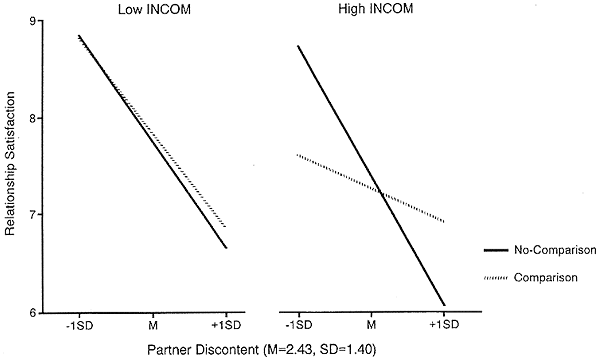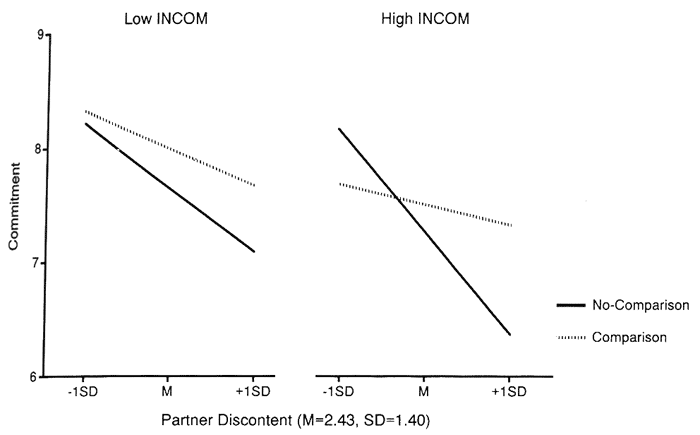 |
Downward comparison in close relationships
A blessing in disguise? |
|||||||
Thesis, University of Groningen, June 1999
© Frans Oldersma, Groningen, The Netherlands, |
||||||||
|
||||||||
Chapter 2: Consequences of cognitive downward comparison for the perceived quality of the relationship
Study 2c
Discontent and comparison orientation as moderators of partner-enhancing downward comparison
A field experiment
Results
Data Analytic Procedure
For descriptive purposes, we examined the mean scores of the study variables in the experimental conditions, as well as the correlations between all study variables. Next, hierarchical moderated regression analyses were conducted to test the hypotheses concerning the extent to which cognitive set predicted participant's levels of relationship satisfaction and commitment, the two-way interactions between cognitive set and discontent with the partner on the one hand, and cognitive set and social comparison orientation on the other hand, and the three-way interaction between cognitive set and the two moderator variables.
In Step 1, cognitive set (0 = no-comparison thought-generating task and 1 = downward comparison thought-generating task), discontent with the partner, and social comparison orientation were entered simultaneously. In Step 2, the three two way interaction terms (Cognitive Set X Discontent, Cognitive Set X Comparison Orientation, Discontent X Comparison Orientation) were added to the regression equation. Finally, in Step 3, the three way interaction term (Cognitive Set X Discontent X Comparison Orientation) was entered.
To test and interpret these interactions, procedures outlined by Aiken and West (1991) were followed to calculate regression slopes and plots. Following Aiken and West, before the interaction terms were calculated, the criterion variables and all continuous predictor variables (i.e., discontent and comparison orientation) were standardized to reduce possible multicollinearity among the independent and interaction terms as well as to facilitate interpretation of the interaction effects. Furthermore, for each continuous predictor, participants with scores one standard deviation above the mean were labelled high social comparison orientation or high discontent with the partner, and those with scores one standard deviation below the mean were labeled low social comparison orientation or low discontent (following Cohen & Cohen, 1983). Where appropriate, significance values concern one tailed tests; two-tailed tests are reported if the direction of the slopes were contrary to the predictions or if no specific predictions were made.
Preliminary Descriptive Analyses
Table 1 presents, separately for participants in the no-comparison and the downward comparison conditions, the means and standard deviations for the variables used in Study 2. Preliminary one-way analyses of variance with cognitive set (no-comparison versus downward comparison) as independent variable indicated that neither the moderator nor the dependent variables were related to cognitive set, Fs < 1, ns. As can be seen from Table 1, the variables measuring relationship quality were significantly correlated. Not surprisingly, especially relationship satisfaction and the moderator variable relational discontent were highly correlated. Furthermore, comparison orientation showed small, but statistically significant relations with the relationship variables.
Regression Analyses
Relationship satisfaction. The main effects of cognitive set, discontent, and social comparison orientation accounted for a significant amount of variance in relationship satisfaction, |
|
TABLE 1
Pearson correlations among variables and means as a function of cognitive set in study 2
* p < .05; ** p < .001, one-tailed. Parenthetical values are standard deviations.
a N = 56; b N = 60
The two-way interactions entered at the second step yielded a significant incremental amount of explained variance,
However, this interaction was qualified by the expected three-way interaction that accounted for an additional amount of explained variance in relationship satisfaction (B = .35),
As shown in Figure 1, and in line with the predictions, at low levels of social comparison orientation the Cognitive Set X Discontent interaction was not significant (B = .09, t(109) = .44, ns), whereas a significant interaction term was found at high levels of social comparison orientation (B = .78, t(109) = 5.04, p < .0001). The slopes of the standardized form of the equation, and their significance levels were as follows: Among participants low in social comparison orientation, discontent was an equally important predictor of satisfaction in the downward comparison condition (B = -.77, t(108) = 4.53, p < .0001) as well as in the no-comparison condition (B = .86, t(108) = 7.16, p < .0001). In contrast, for those high in social comparison orientation, discontent was less strongly related to satisfaction in the downward comparison condition (B = .27, t(108) = 2.53, p < .02) than in the no-comparison condition (B = -1.05, t(108) = 9.31, p < .0001).
 FIGURE 1. Study 2: Regression of relationship satisfaction on discontent about the partner as measured prior to the experimental task within the no-comparison and downward comparison conditions. Relationship satisfaction was regressed on discontent at low (1 SD below the mean) and high (1 SD above the mean) levels of social comparison orientation (INCOM; M = 2.97, SD = .59).
Thus, in line with our prediction, the Cognitive Set X Discontent interaction appeared to be stronger for participants high in social comparison orientation, indicating that cognitive downward comparison led to a relatively better relationship quality among individuals high in discontent only when they were high in social comparison orientation.
Commitment to the relationship. The main effects of cognitive set, discontent, and social comparison orientation accounted for a significant amount of variance in commitment, |
|||||||||||||||||||||||||||||||||||||||||||||||||||||||||||||||||||||||||||||||||||||||||||
|
The entry of the two-way interactions at the second step did not account for further incremental variance in commitment,
As expected, this two-way interaction was qualified by the three-way interaction that accounted for a just significant portion of explained variance in commitment (B = .35),
As shown in Figure 2, for participants low in social comparison orientation, discontent significantly predicted commitment in both the downward comparison condition (B = -.56, t(108) = 2.43, p < .02), and within the no-comparison condition (B = -.48, t(108) = 2.96, p < .005). In contrast, for those high in social comparison orientation, discontent was not at all associated with commitment in the downward comparison condition (B = -.15, t(108) = 1.05, ns), whereas in the no-comparison condition there was a highly significant association between both variables (B = -.78, t(108) = 5.06, p < .0001). Thus, especially for participants who were strongly inclined to engage in social comparison, cognitive downward comparison contributed to a relatively higher commitment among those experiencing a high discontent with the relationship.
 FIGURE 2. Study 2: Regression of commitment to the relationship on discontent about the partner as measured prior to the experimental task within the no-comparison and downward comparison conditions. Commitment was regressed on discontent at low (1 SD below the mean) and high (1 SD above the mean) levels of social comparison orientation (INCOM; M = 2.97, SD = .59).
Supplemental analyses
As in study 1, it was examined again if the number of the qualities generated in both conditions could account for the results. There was no effect of cognitive set, F(1, 114) = .01, ns, upon the number of qualities generated. To determine whether the number of qualities did account for the effects on satisfaction, commitment and perceived relationship quality, the hierarchical moderated regression analyses were repeated after adding the number of the qualities in the first step. In these analyses, all of the major findings were replicated. |
|
||||||
 |
© Frans Oldersma. Mail: Frans Oldersma
Painting: L'Autunno by Laurens Boersma Webdesign: Smeets & Graas | Een Groninger Website |
|||||